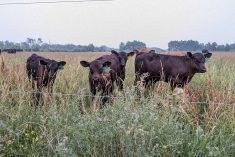U.S. feeder cattle futures slipped a half per cent on Tuesday as Chicago Board of Trade corn futures rose, leading to reduced demand for feeders due to the potential for higher costs to feed young cattle to market weight, analysts and traders said.
“Feed costs are already through the roof and with another rally in corn futures, that just puts another cap on feeders,” said Sterling Smith, market strategist for Citigroup.
Spot August feeders hit a two-month high in early dealings the previous trading session on prospects for corn prices to keep falling. U.S. farmers planted the largest corn acreage since the 1930s and soil moisture reserves in the Midwest had been replenished following the worst drought in over 50 years last season.
Read Also

U.S. livestock: CME cattle tick lower in thin pre-holiday trade
Chicago | Reuters – Chicago Mercantile Exchange live and feeder cattle futures were little changed but ended slightly lower on…
But feeders are falling as CBOT new-crop December corn futures rallied back to late June price levels on Tuesday on forecasts for hot and dry weather in the western Midwest, which could trim crop output and strengthen prices of corn and related costs to feed cattle.
CME August feeder cattle were down 0.45 cent/lb. at 151.15 cents, and September feeder cattle were down 0.475 cent/lb. at 153.675 cents (all figures US$).
Cash prices for feeder cattle countered the move of futures on reports of persistent good demand for young cattle to place in the nation’s feedlots.
The benchmark Oklahoma City feeder cattle auction on Tuesday reported feeder steers $3 to $5 per hundredweight (cwt) higher than a week ago, with some over 900 lbs. up to $10 higher.
Demand was good following the U.S. Independence Day Holiday and feedyards were still actively trading for feeder cattle despite the lacklustre slaughter cattle trade.
Live cattle up on technicals
Live cattle futures closed higher, with spot August recouping recent losses and bouncing back to the highs set in late June on technical short-covering on thin volume.
Traders and analysts said there was little if any fundamental reason for cattle to close higher since wholesale beef markets kept sliding and expectations are for cash cattle to ease again this week, mirroring last week’s slide.
“Beef is sharply lower and I think it has to work even lower to discover demand,” said Dennis Smith, a broker for Archer Financial.
CME cattle for August delivery closed up 0.65 cent/lb. at 122.725 cents, and October cattle futures were up 0.525 cent/lb. at 126.7 cents.
Choice wholesale beef carcasses were down another 40 cents/cwt at $194.45 on Tuesday, but lower-quality select carcasses were up 57 cents at $185.70.
“We’ve already been seeing better demand for chicken at the restaurant and retail level,” Citigroup’s Smith said.
“And now with plus-90-degree (F) temperatures moving in to the feedlot region, that will spur movement of cattle to market, which is near-term bearish,” he said.
Estimated profit margins for U.S. beef packing companies were a positive $51.65 per head on Tuesday, down from $63.60 on Monday and below the $60.60 per head profit of a week ago, according to Denver-based livestock marketing advisory service HedgersEdge.com LLC.
Lean hogs mixed, seeking direction
Lean hog futures closed mixed with nearby contracts easing on signs cash hog prices may be peaking, but there was little bearish momentum due to solid demand for retail pork.
“Pork demand is really quite good relative to beef because of its lower price and now with chicken prices firming up, that spurs even more demand for pork, the other white meat,” Citigroup’s Smith said.
“But technically hogs need to hold above the $95 level,” he said.
Chicago Mercantile Exchange lean hog futures for July delivery closed down 0.275 cent/lb. at 100.85 cents, and August was down 0.375 cent/lb. at 95.175.
Deferred hog futures contracts were up from 0.15 cent/lb. to up 0.9 cent, with the biggest gainers in the 2014 futures contracts.
Cash hog markets in the Midwest were mostly steady and the supply was trimmed as hotter weather moved into the region, dealers said.
Archer’s Smith said Tuesday’s gains in some hog futures contracts were just a short-covering bounce and a pause from the sharp declines of prices on Monday.
“Packers are looking to buy hogs at lower levels, so I’m looking for another sweep down in price,” he said.
Estimated profit margins for U.S. pork packing companies were a positive $6.85 per head on Tuesday, up from $2.65 on Monday but below the $11.60 per head profit of a week ago,
according to HedgersEdge.com LLC.
— Sam Nelson is a Reuters correspondent reporting on ag commodity futures markets for Reuters from Chicago.














